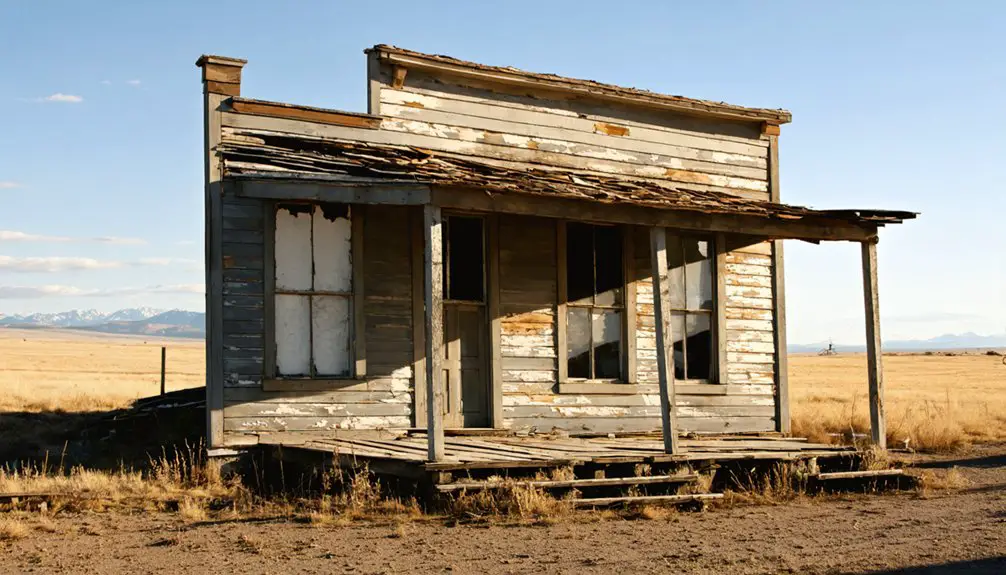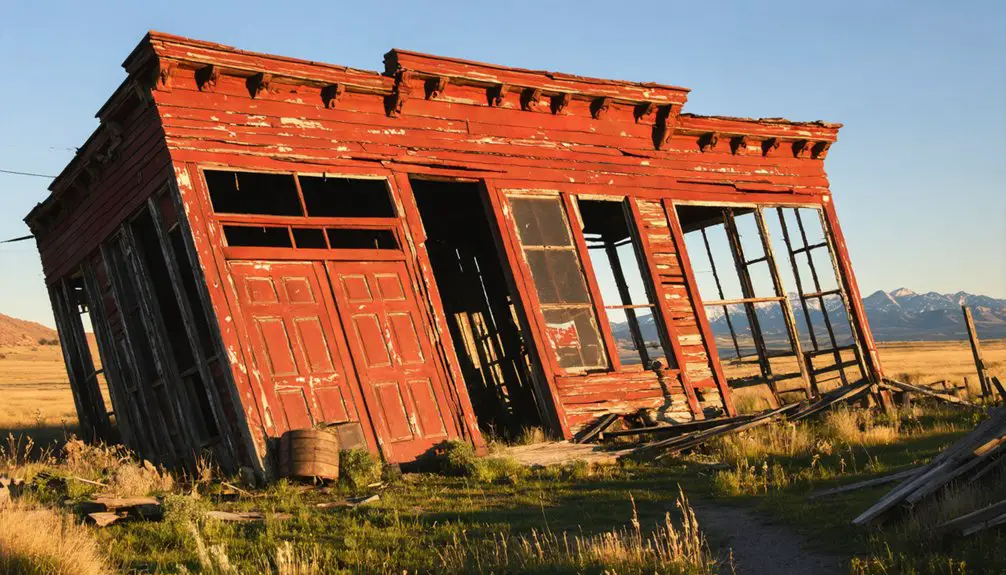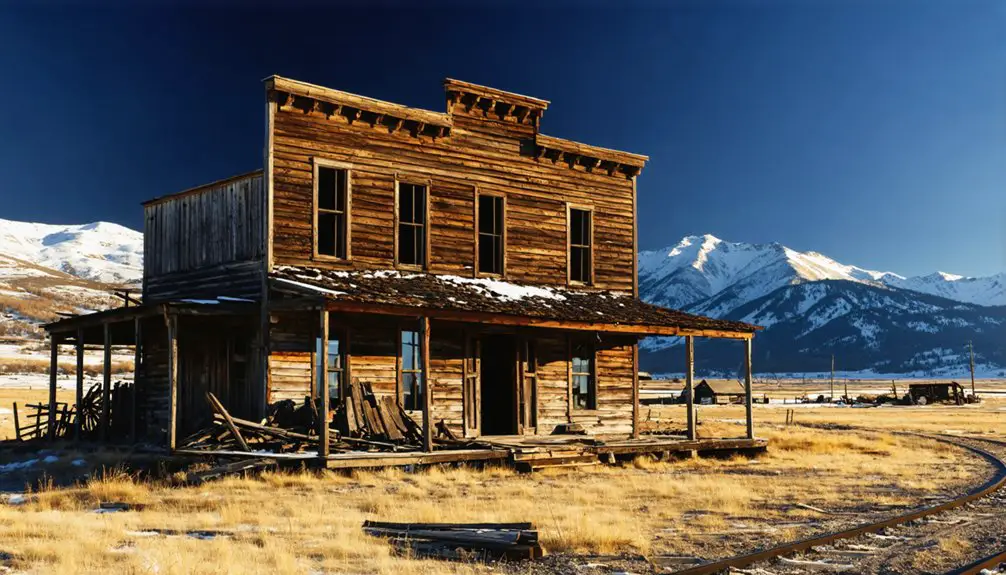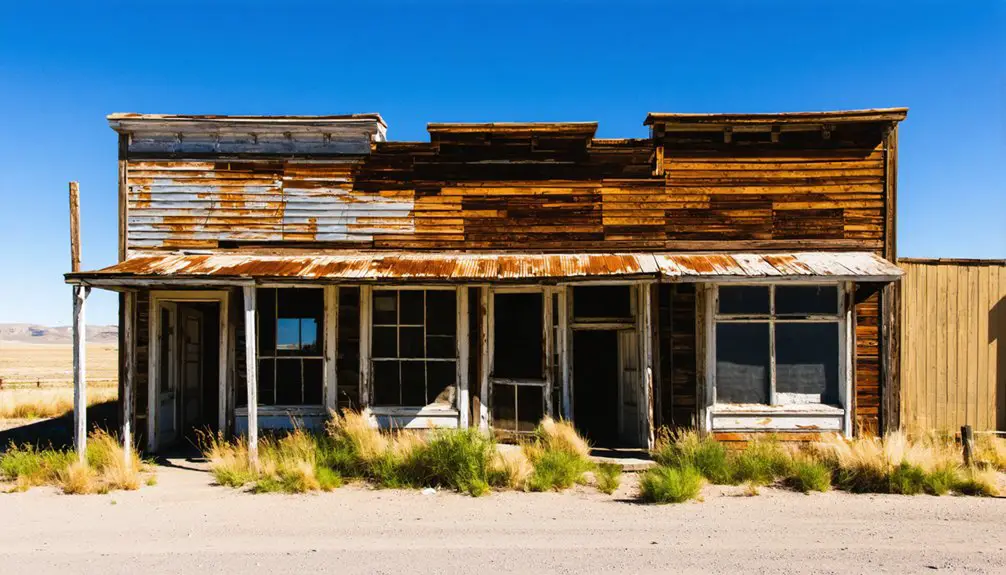You’ll find Capitol among Montana’s historic mining settlements, established during the 1860s gold rush when prospectors flocked to the region’s rich deposits. The town flourished briefly as miners extracted approximately $30 million in gold during the first three seasons, while vigilante justice maintained order in the lawless frontier. Today, Capitol’s preserved structures and architectural remnants stand as silent witnesses to Montana’s mining heritage, offering glimpses into the daily lives of those who shaped the American West.
Key Takeaways
- Capitol emerged during Montana’s 1860s gold rush, with mining operations centered along Grasshopper Creek.
- Miners and families established a vibrant community with saloons and a Masonic Lodge serving as social hubs.
- The town’s economy relied on railroad connections for transporting ore, equipment, and essential supplies between mining communities.
- Capitol faced typical mining town challenges including lawlessness, leading to vigilante justice before official courts were established.
- Like many Montana mining towns, Capitol declined when gold resources depleted in the early 1900s despite technological advances.
The Birth of a Mining Frontier
While Montana’s mining history officially began with the 1852 gold discovery near Gold Creek, it wasn’t until the early 1860s that the territory’s mining frontier truly emerged.
You’ll find the roots of this transformation at places like Bannack and Alder Gulch, where prospecting challenges drove pioneers to establish the first substantial mining camps in 1862-1863.
The mining techniques evolved rapidly as prospectors pushed their luck, leading to the legendary Last Chance Gulch discovery in 1864 – a find that would birth the future city of Helena.
Last Chance Gulch emerged from relentless prospecting in 1864, transforming a desperate mining venture into Montana’s capital city.
As the 1860s progressed, you’d have witnessed a dramatic shift from basic placer mining to more sophisticated quartz operations, with early efforts establishing a quartz mill in 1868.
Mining courts emerged to handle claim disputes, though they struggled to contain the lawlessness that accompanied this bustling frontier’s explosive growth.
The discovery at Grasshopper Creek sparked Montana’s first major gold strike, drawing thousands of fortune seekers to the area.
Gold Rush Legacy and Early Settlement
You’ll find that Capitol’s story mirrors many Montana mining settlements where fortunes were made and lost in the tumultuous 1860s gold rush era.
Like other boomtowns that emerged during this period, the community had to quickly establish basic law and order systems to manage the influx of miners and entrepreneurs seeking their share of mineral wealth.
The discovery at Last Chance Gulch sparked the area’s rapid transformation from wilderness to bustling settlement. The stark reality of frontier justice and self-governance became evident as the settlement worked to maintain stability while processing millions in gold deposits through its camps and claims. The discovery of massive gold deposits yielded approximately $30 million worth of gold during just the first three seasons of mining operations.
Mining Fortunes and Failures
Montana’s gold discoveries in the 1860s sparked a transformative era of mining that would shape the territory’s future development.
You’ll find that early mining techniques evolved quickly from simple placer operations yielding up to $1,000 per day to more complex hard rock mining operations. The economic impacts were staggering – Helena’s Last Chance Gulch produced $170,000 in its first year alone. Trade boomed as saloons and dancehalls filled the bustling mining camp.
As surface gold became scarce by 1874, you’d have seen dramatic shifts in mining operations. While some miners struck it rich, others abandoned their claims due to declining yields and strict legislative requirements. The discovery by the Four Georgians in 1864 launched Helena’s meteoric rise as a mining settlement.
The Alta mine near Corbin yielded $32 million, and the Whitlatch-Union Mine produced $6 million over four decades. These successes helped transform Helena into Montana’s wealthiest city, boasting the highest concentration of millionaires per capita.
Law and Order Challenges
As gold fever swept through Montana’s mining camps in the 1860s, lawlessness and violence followed in its wake.
With minimal law enforcement in place, Capitol and surrounding settlements faced a wave of murders, assaults, and robberies. The notorious “Innocents” gang alone committed over 100 murders in just one year.
You’d have witnessed the rise of vigilante justice as communities fought back against the chaos. The Montana Vigilantes took matters into their own hands, even hanging corrupt officials to restore order. Their most significant action came when they executed Henry Plummer’s Innocents for their reign of terror.
Mining courts, originally created to settle claim disputes, proved inadequate for serious crimes. It wasn’t until Montana gained territorial status in 1864 that official courts emerged, bringing the first real semblance of legal authority to these wild frontier towns.
Daily Life in Capitol’s Heyday
Life in Bannack during its heyday centered around the bustling gold mining operations along Grasshopper Creek, where over 3,000 residents forged their frontier existence by 1863.
Your daily routines would’ve revolved around the challenging work of mining, whether you’re operating pumping machines or working claims along the creek.
You’d find community events happening at the town’s saloons and Masonic Lodge, which served as gathering spots after long workdays.
The discovery of Montana’s largest gold nugget at the nearby Cable Mine brought a fresh wave of excitement and optimism to the region.
You’d likely stuff your cabin walls with newspapers for insulation against the harsh weather, and carefully manage your resources given the high cost and scarcity of supplies.
The Masonic Temple doubled as your children’s schoolhouse, while the narrow streets lined with three blacksmith shops and saloons formed the heart of your social world, despite the ever-present dangers of frontier life.
Notable Characters and Local Legends
While gold discoveries brought thousands to Montana’s mining towns, certain characters left an indelible mark on the region’s history.
You’ll find tales of Sheriff Henry Plummer, who embodied the complex nature of frontier justice as both lawman and alleged outlaw leader. Local folklore tells of dangerous “road agents” who claimed up to 100 lives along the region’s travel routes, spurring vigilante groups to take matters into their own hands.
The area’s legendary outlaws and their confrontations with justice shaped the cultural landscape of mining communities throughout the 1860s and 1870s. Bannack’s territorial capital status drew even more colorful characters to the bustling frontier town.
Mining camp rivalries and gold claim disputes added to the colorful tapestry of pioneer stories, while reenactments at places like Bannack Days keep these dramatic tales alive for modern visitors.
Architecture and Infrastructure

You’ll find the buildings of Capitol constructed with a mix of Montana sandstone and granite, reflecting both local resource availability and the town’s brief but prosperous period.
The structures featured copper-topped designs and Greek neoclassical elements, mirroring architectural trends common in Montana’s early 20th-century boom towns.
The town’s remaining foundations and partial walls showcase the detailed stonework and craftsmanship that went into the buildings’ construction, particularly in the placement of locally quarried stone that was chosen despite its higher cost.
Building Materials and Methods
The architectural grandeur of Montana’s original State Capitol emerged from locally-sourced materials, with Montana sandstone and granite forming its primary construction elements. The building’s design celebrated local geology through carefully selected stone that reflected the region’s natural character.
You’ll find evidence of masterful stone craftsmanship throughout the structure, where late 19th-century masons combined traditional hand techniques with emerging mechanical tools.
While the original sandstone facade faced weathering challenges, the legislature mandated the use of more durable local granite and limestone for later expansions.
Steel framework supported the massive dome internally, while elaborate stone carvings, capitals, and pilasters adorned the exterior in Greek neoclassical style.
The integration of different stone types required precise jointing and anchoring to address variations in hardness and weathering characteristics.
Historic Design Features
Building upon its robust foundation of local stone, Montana’s original State Capitol showcased Greek neoclassical architecture with Renaissance Revival interior influences.
You’ll find historic murals throughout the building depicting Native Americans, explorers, miners, and cowboys, with architectural symbolism evident in every corner. The central rotunda, crowned by a copper dome and Montana statue, serves as the building’s heart.
You can explore grand public spaces leading to state offices, where Charles M. Russell’s massive “Lewis and Clark Meeting the Flathead Indians” painting spans 25 feet.
The Capitol’s pioneering electrical system illuminated elaborate stonework, stained glass, and commissioned artwork in the Senate and Old Supreme Court chambers.
Four circular paintings around the rotunda represent key moments in Montana’s territorial history, while Jeannette Rankin’s statue stands proudly on the second floor.
Economic Rise and Decline
Founded primarily due to rich mineral deposits, Capitol experienced dramatic economic swings that mirrored Montana’s broader mining frontier.
The town’s economic resilience was tested through various mining innovations, from early stamp mills to electric dredging operations, as it fought to maintain its prosperity amid changing market conditions.
- Your community’s initial growth exploded with gold and silver discoveries, attracting thousands of workers and supporting businesses.
- You’ll find the Sherman Silver Purchase Act of 1890 briefly boosted the town’s fortunes before its 1893 repeal devastated the local economy.
- Your town’s mines struggled against resource depletion by the early 1900s, despite technological advances.
- World Wars temporarily revived mining activity, but you couldn’t overcome competition from larger operations and declining ore quality.
Preservation Efforts and Current Status

Since becoming a National Historic Landmark in 1961, Capitol’s preservation has relied on a coordinated effort between government agencies, non-profit organizations, and dedicated community members.
The Montana State Park Service manages the site under a “preserved rather than restored” philosophy, focusing on protecting original structures while maintaining the authentic ghost town atmosphere.
Local preservation challenges include harsh weather conditions and natural decay of buildings, requiring constant attention and funding.
You’ll find community involvement through annual events like pioneer life demonstrations and historical reenactments, which help raise awareness and support ongoing conservation efforts.
Volunteer programs and university partnerships facilitate maintenance while ensuring Capitol’s historical integrity remains intact.
The site’s preservation balances sustainable tourism with heritage protection, preventing commercial overdevelopment while supporting local economic interests.
Exploring the Ghost Town Today
As you walk down Bannack’s main street today, you’ll find over 60 original frontier structures that showcase authentic mining town architecture from the 1860s through the 1930s.
The well-preserved buildings, including the historic Graves House, Masonic Temple, and Meade Hotel, allow you to step inside and examine period-specific construction methods and materials up close.
Through interpretive signage and seasonal reenactments like Bannack Days, you can connect with the daily lives of the miners, merchants, and families who once called this gold rush settlement home.
Walking Through History Today
When exploring Capitol ghost town today, visitors must navigate challenging backcountry terrain to reach this remote slice of Montana’s mining history.
You’ll discover weathered foundations, scattered mining debris, and historical artifacts that tell the story of a once-thriving community’s cultural impact. Without formal guides or interpretive signs, you’re free to explore at your own pace through this authentic piece of the American West.
- Pack essential supplies including water, food, and first-aid kit – there’s no visitor center or services nearby
- Wear sturdy hiking boots to safely navigate unstable ground and building remnants
- Bring a camera to capture the rustic ruins against the forested landscape
- Study GPS coordinates and trail maps beforehand, as signage is minimal in this remote location
Preserved Buildings Tell Stories
The preserved buildings of Bannack stand as silent storytellers of Montana’s first territorial capital. You’ll find nearly 60 original structures that survived time’s passage, each offering ghostly encounters with the past.
From the sheriff’s office where vigilante justice played out, to the Masonic Lodge’s architectural symbolism reflecting frontier society’s organization, every building holds authentic tales.
You’re free to explore well-preserved homes with period furnishings, peek into old saloons where miners once gathered, and investigate the schoolhouse where frontier children learned.
Mining equipment and shaft remnants scatter the landscape, revealing the town’s golden foundation. Through careful preservation efforts since 1954, these buildings maintain their original character, allowing you to touch, feel, and experience genuine pieces of Montana’s territorial history.
Historical Significance in Montana Territory

Following its establishment after the 1862 gold discovery at Grasshopper Creek, Bannack quickly emerged as a pivotal settlement in Montana Territory’s early development.
As the first territorial capital, it played an essential role in shaping Montana’s early governance and multicultural dynamics, hosting the first Territorial Legislature in 1864.
You’ll discover Bannack’s remarkable historical significance through these key aspects:
- Served as the center of territorial governance during a critical year of formation (1864-1865)
- Drew a diverse population of 3,000, including 300 Chinese workers who enriched the community
- Generated $2-3 million in gold by 1876, establishing Montana’s placer mining industry
- Fostered civic development through organizations like the Masonic Lodge and Vigilante Committees
The settlement’s rapid growth and eventual decline exemplify the dynamic nature of frontier development in the American West.
Connecting With Other Mining Communities
Through its strategic position in southwestern Montana’s mining district, Capitol forged essential connections with larger hubs like Butte, creating an intricate network of economic and social ties.
You’d find miners and their families frequently moving between these communities, sharing cultural traditions and labor solidarity movements that shaped the region’s identity.
Community collaboration flourished as Capitol’s businesses relied on established supply chains and banking services from larger towns.
Railroad links enabled the efficient transport of ore, equipment, and provisions, while regional mining fairs facilitated trade.
The town’s miners benefited from technological innovations and safety practices developed in Butte, while shared equipment like stamp mills and smelters enhanced operational efficiency.
This interconnectedness meant that economic fluctuations in one town directly impacted the others, binding these mining communities in their shared destiny.
Frequently Asked Questions
What Role Did Native American Tribes Play in Capitol’s Development?
You’ll find Native American influence shaped Capitol through tribal relations, trade partnerships, and early settlement cooperation, though their presence diminished as European settlers increasingly claimed traditional hunting territories.
How Did Extreme Weather Conditions Affect Mining Operations in Capitol?
When you’re battling -20°F winter storms, you’ll see how weather impacts devastated Capitol’s mining productivity through frozen equipment, dangerous shaft conditions, seasonal shutdowns, and constant disruptions to ore transportation.
Were There Any Major Epidemics or Health Crises in Capitol?
You won’t find records of major epidemics in Capitol, despite typical mining town health risks. While poor sanitation and crowded conditions existed, there’s no documented evidence of widespread epidemic impact or health measures.
What Happened to the Mining Equipment After the Town Was Abandoned?
You’d be intrigued to know that most abandoned machinery stayed right where it stood. Without historical preservation efforts, much of Capitol’s mining equipment deteriorated on-site or was gradually salvaged by others.
Did Capitol Have Any Significant Conflicts With Neighboring Mining Communities?
You won’t find records of major Capitol rivalries or mining disputes with neighboring towns. While competition for resources existed, there’s no evidence of significant conflicts between Capitol and other communities.
References
- https://destinationmissoula.org/ghost-towns
- https://leisuregrouptravel.com/the-gold-west-region-of-montanas-mining-heritage/
- https://virginiacitymt.com/Experience-The-Old-West/index
- https://www.mountain-home.com/blog/vacation-planning/guide-montana’s-ghost-towns
- https://en.wikipedia.org/wiki/Bannack
- https://www.mininghistoryassociation.org/ButteHistory.htm
- https://treasurestatelifestyles.com/how-mining-shaped-montana/
- https://npshistory.com/publications/usfs/region/1/flathead/history/chap3.htm
- https://www.mtmemory.org/nodes/view/91417
- https://montanakids.com/agriculture_and_business/mining/Early_days_of_Mining.htm



